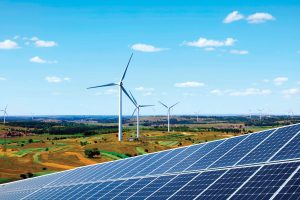
In the early 2000s, solar and wind energy development was a distant reality in India. However, with the growing need and demand for sustainability, the adoption of green technology became imperative. As the requirement for renewable energy grew and consumers as well as businesses became increasingly conscious of taking steps towards a sustainable future, it facilitated the much-needed adoption of green energy.
Since then, the renewable energy market in India has progressed considerably with further market expansion for the commercial and industrial (C&I) segment arising from the introduction of the recent Green Energy Open Access [GEOA] rules and the General Network Access [GNA] Rules by the central government. Moreover, many states across the country, by adopting an open access market, have helped drive awareness and adoption among C&I consumers, leading to rapid growth of this segment.
India has set an ambitious target of achieving 500 GW of renewable energy capacity by 2030 towards the larger goal of a green revolution, and to achieve this target, focused steps are being taken by various stakeholders. Several states across the country have proactively adopted parts of the GEOA Rules, which now allows customers to avail of the open access facility with as little connected load as 100 kVA, a significant change from the previous requirement of 1 MVA. Cost economics and the speed of regulatory adoption stand as the primary factors for the impact of this change to be felt; this is particularly significant for moderate- to low-demand customers who are keen on embracing green power, backed by consistent support in terms of banking for state-level renewable energy projects.
The introduction of the GEOA Rules, aimed at providing ease of access for green open access to C&I consumers, has helped considerably in reforming the energy open access market landscape. It also provides clarity with regard to long-term open access charges and banking norms. With the policy impetus from the central government and the drive towards affordable green power adoption by consumers, there has been a need for greening of the supply chain as global consumers demand sustainable products and services offered by the Indian manufacturing and services industry. This need is further accelerating enforcement norms on green power procurement for factories, data centres, technology parks, and even small retail units.
In India, C&I consumers pay higher tariffs to cross-subsidise agricultural and residential consumers. With the states allowing for monthly banking of renewable energy and the CTU network allowing for almost 70 per cent round-the-clock (RTC) power with renewable energy and without storage, it is quite pragmatic to displace 70-80 per cent of the fossil fuel energy with hybrid renewable energy. However, the current storage costs of renewable energy do not provide an economically viable alternative for consumers or investors to look for a 100 per cent replacement of fossil fuel energy with renewables, resulting in a true RE100 scenario for consumers. This gap can be bridged by the virtual power purchase agreement (VPPA) model.
VPPA: The missing piece in the RE100 puzzle
VPPA is a bilateral renewable energy financial contract between a renewable energy developer and a consumer. This agreement does not include the physical delivery of energy. The renewable energy developer continues to sell the power in the power exchange as brown power but transfers green attributes to the energy consumer with whom it has signed the VPPA. The consumer is free to source its power requirement in the best possible manner for the remainder of its power needs after reaching a viable renewable energy consumption pattern; however, the green credentials acquired by them support in achieving the RE100 objective.
In a VPPA, a strike price is pre-agreed between the renewable energy developer and the consumer. This price is compared with real-time prices on power exchanges. The difference between the two prices is settled between the parties, ensuring that the renewable energy developer is not suffering losses due to the sale of power on the exchange at prices lower than the strike price and the consumer benefits from the acquisition of requisite green credentials.
C&I consumers in India currently avail renewable power primarily by signing physical power purchase agreements (PPAs) of either on-site (rooftop) or off-site (open access) projects. Renewable energy-based power is highly infirm by nature, and, therefore, it becomes crucial for consumers to have renewable power coupled with storage, which, at present, is not an economically viable proposition for C&I consumers to achieve their RE100 goals. Instead, VPPAs ensure that consumers have 100 per cent flexibility and economic viability, thus helping the country reach its climate goal with minimum financial risk for both the consumer and the developer.
Thus, the benefits of VPPA are plenty at the core, in not just a long-term financial derivative contract wherein green credits (usually in the form of renewable energy certificates) are traded between the renewable generator and consumer but also where the implementation of VPPA helps address various shortcomings traditionally seen in physical PPAs, while contributing to the growth of the renewable energy industry.
Low liquidity on the green power trading market, delayed open access or GNA approvals, lack of clarity on the renewable energy credits registration mechanism and lack of global recognition of the same can derail the crucial step towards reaching the RE100 goal for many Indian and multinational companies. Clarity is also required from the Ministry of Finance on the non-applicability of the Security and Contracts Regulation Act (SCRA) on “non-transferable specific delivery contracts” for sale of green attributes (RECs et al.).
 Future outlook
Future outlook
In the conservative and realistic scenarios, the market size of VPPAs in 2030 will be 22 GW and 69 GW respectively. Accordingly, the VPPA market may contribute 4.4 per cent (conservative), 13.8 per cent (realistic) and 20.8 per cent (optimistic) to the national renewable energy target of 500 GW capacity by 2030.
In keeping with the evolving power trading market in the country, establishing regulatory compliances, developing a mechanism to encourage the ease of adoption, facilitating open access approval and utilising existing platforms for VPPA transactions is crucial.
With the current policy and market scenario facilitating 60-70 per cent of fossil fuel replacement with renewable energy, and the need to make global supply chains green to achieve net zero emissions, it is only a matter of time for the Indian market to evolve and use financially innovative and environmentally sustainable practices such as VPPAs.
To conclude, the outlook for VPPAs in the Indian market is bright, especially for securing large amounts of carbon-free electricity at scale. With the right use of VPPAs, a favourable scenario is created for consumers as it helps bridge the gap between the consumption of renewable energy from physical PPAs and the total power consumed. Moreover, VPPAs typically result in additionality, meaning that they add new renewable energy facilities to the grid. VPPAs, indirectly through additional renewable energy generation facilities, also generate local jobs and spur economic growth, particularly in rural and low-income communities, and increase state and local tax revenues. When holistically looked at and compared to other sustainable energy opportunities, VPPAs offer a low-friction model and a faster way to cut down carbon emissions.


